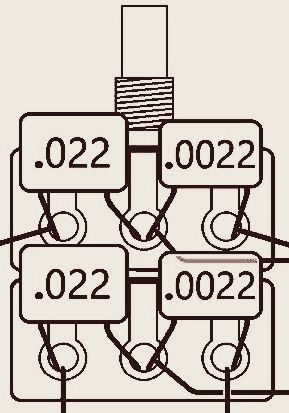

Capacitors
Selecting for the lowest distortion
Capacitors
Selecting for the lowest distortion
Capacitors are available in many flavors, from low-cost general purpose capacitors to high-end Audiophile grade capacitors that can get very costly. Searching audio forums, you will find discussions as to which capacitors sound better. You might consider selecting capacitors from a technical viewpoint. More expensive does not necessarily mean better.
All capacitors work on the same principal, two plates separated by an insulator (dielectric) that blocks DC while allowing AC on one plate to appear on the other plate; audio is a form of AC. In amplifier audio circuits, capacitors are used in various places along the audio path. From a technical point of view, you would think that something as simple as two plates separated by an insulator would all perform the same and sound the same.
Not necessarily. It is not unreasonable to say that some capacitors may perform better than others depending on the materials or manufacturing process used. Rather than depend on statements of performance stated by individuals or component suppliers (after all, they are trying to sell you something), technical testing with comparison of different types of capacitors would be more definitive.
A Texas Instruments Analog Design Journal article, Selecting Capacitors to Minimize Distortion in Audio Applications, written by Zak Kaye, Applications Engineer, provides insight. If interested, the article is available here. Test results presented in the article are applicable to use in audio amplifiers.
The article primarily deals with solid state circuit voltages. Keep in mind that it is the AC performance of a capacitor that is important. The voltage rating of a capacitor depends on the circuit the capacitor is used in. Also, the article considers tiny surface mounted capacitors used on printed circuit boards. Capacitor size is inconsequential, it is the type of capacitor that matters. For vacuum tubes, larger sized capacitors are used, usually with wire leads for point to point wiring.
On the conclusion page, there are two types of capacitors recommended for lowest distortion. The C0G/NP0 (multilayer ceramic) and film (polyethylene or polypropylene) type capacitors. Multilayer ceramic capacitors with C0G/NP0 dielectric plus long wire leads and high voltage ratings are difficult to find.

Capacitors Across Pot Terminals

However, C0G/NP0 multilayer ceramic capacitors with short leads are useful for close terminal connections such as across pot
terminals. Polyethylene or polypropylene film capacitors with high voltage ratings and long wire leads are available for normal
point to point wiring.
Sample of suppliers:
Antique Electronic Supply
Amplified Parts
Just Radios Capacitor Order Form
In Zak Kaye's article, he mentions that to reduce its distortion, increase the value of a capacitor until its impedance is low enough in the band of interest (for instance, 20Hz to 20,000Hz). It's a matter of calculating the –3 dB cutoff frequency of the capacitor-load impedance to the lowest possible value. For instance, a .47uF capacitor will have a lower –3 dB cutoff frequency than a .1uF capacitor. It would also be wise to voltage rate capacitors with a generous safety factor. For example, a 600 volt rated capacitor in a 400 volt circuit. If on a tight budget, low-cost polyethylene or polypropylene film capacitors are available. With careful circuit design, they should perform as well as any other polyethylene or polypropylene capacitor.
